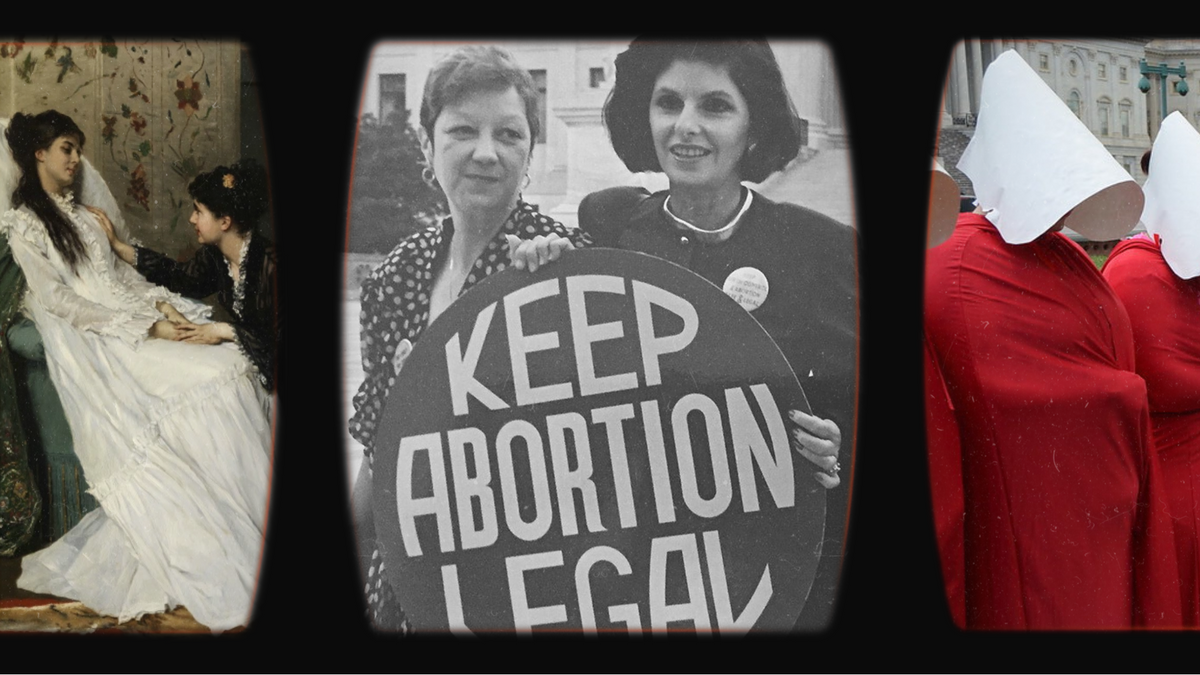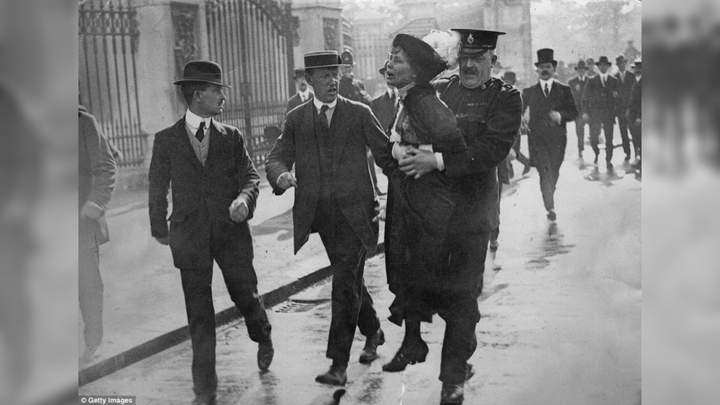Unmasking the Misunderstanding of Abortion History
“Puritan attacks were based on the notion that female morality could be upheld by instilling fear of pregnancy in women.”

Until 1968, scholars had neglected to produce or analyze the history of abortion in Anglo-American law. Professor Cyril Means was a member of the Governor’s Commission appointed to review New York State’s Abortion Law and his exhaustive research was incorporated into that Report, which was the first history of abortion. The Report noted that abortion was not illegal in either England or America before the nineteenth century, and that even when abortion was banned in the 1800’s, the purpose was solely to protect the life of the mother. Professor Means’ history, described as the “new orthodoxy,” is now accepted by the vast majority of legal scholars.
The practice of abortion was common throughout history. Records show that the Romans relied on the juice of the now-extinct silphium plant to induce abortions, while the Greeks employed the herb pennyroyal for the same purpose. However, the starting point for the present discussion must be the common law decisions that preceded the first state anti-abortion laws passed in America.
In England between 1327 and 1803, and in the United States between 1607 and 1830, the Common Law afforded women the right to have an abortion. Means cited the writings of Sir William Staunford (1509–1558), a judge of the Court of Common Pleas, and William Lambarde (1536– 1601), a legal critic, who both claimed that an unborn child was not a person in rerum natura and consequently its death was not murder. The term “animated” was interpreted to have both “physical and philosophical underpinnings.”
While doctors during the Middle Ages had no dependable methods of determining when a woman was pregnant, both theologians and philosophers alike argued that a fetus was not a human being until “ensoulment, or animation, the point between conception and birth at which the fetus acquires a rational soul.”
By the seventeenth century, cases dealing with abortion fell within the jurisdiction of the Crown, rather than Church courts. At this point, commentators began to place a greater emphasis on whether a woman was “quick with child,” rather than pregnant, in discussions on abortions.
Once abortion fell within the jurisdiction of the common law courts, the quickening doctrine was adopted as the legal standard for differentiating between legal and illegal abortions.
“The practice of abortion was common throughout history.”
In 1803, abortion became a felony offense in England. The statute was developed by the Chancellor of England, Lord Ellenborough, a moralist and traditionalist. No adequate explanation has been given for Lord Ellenborough’s Act, but it is clear that this law criminalized abortions at all stages of pregnancy. Incredibly, the Act made successful abortions prior to quickening a crime punish- able only by a fine, while the mere attempt to perform an abortion after quickening could yield a death sentence. The inconsistencies in Lord Ellenborough’s Act were “rectified” in 1828, when all surgical abortions were made illegal, and the punishment for pre-quickening abortions reduced.
The English abortion law was not immediately adopted in the United States. In fact, prior to 1821 prosecutions for abortion in the United States were “virtually nonexistent.” There is evidence that abortion after quickening had been a crime in the Colonies prior to the Revolution. However, after the United States gained its independence, there is no evidence to suggest abortion was treated as a crime during the first few decades of the new nation. Instead, reform movements in America sought to adopt laws that lacked the “brutality of the English criminal code.” Thus, when the first reported abortion cases took place in Massachusetts in 1812, the Supreme Judicial Court dismissed the charges when the prosecution failed to prove that the woman had quickened.
In 1821, Connecticut became the first state to ban post-quickening abortions. The primary purpose of the law was to prosecute abortionists, rather than women. In practice, charges were only brought when a woman died or was grievously injured. In the following decade, Missouri, Illinois, and New York legislators adopted laws with a wording similar to the Connecticut statute. However, the statutes in Missouri and Illinois notably excluded the quickening doctrine.
Nevertheless, prior to 1840, all but eight of the states retained the common-law right to pre-quickening abortions. The few prosecutions that took place suggest that the change was not intended to treat the embryo as a victim of a crime. Other facts also support the proposition that the earliest American abortion laws were designed to protect the woman rather than the fetus. For example, it is indicative that in the two decades after Connecticut passed its law, no state abortion law punished the pregnant woman. Thus, until the 1840’s state abortion laws were passed because of a greater recognition that abortion procedures were unsafe and a threat to the life of the mother.
Attitudes towards abortion in America began to change around the 1840’s due to three factors:
- The perceived frequency of abortions by white, middle-class, Protestant, married women
- the dangers of abortion, and
- the activism of physicians in opposition to abortion.
The process of commercialization brought abortion to the forefront of public attention in the early 1840’s. Members of the medical community competed fiercely for clients in the new abortion industry. As a result, advertisements quickly became common practice, appearing in urban and rural newspapers, popular magazines and journals.
After 1840, abortions increased and rates rose from one abortion for every twenty-five to thirty live births at the turn of the century to one for every five or six by the middle of the nineteenth century. One reason for this change was that married women began to desire limiting their family size. A further piece of evidence for an increase in abortions is an almost four percent decline in birth rates from 1800 to 1900. It is worth noting that the increase in abortion rates was not simply due to more abortions taking place, but also due to the increased visibility of abortion. This had the important effect of changing public perception towards the belief that abortions were more common than earlier in American history. As a result, physicians and politicians alike grew concerned that white married women had begun using abortion as a method of birth control.
In the mid-1800’s, scholars writing on abortion were describing the practice as common to “every village, hamlet, and neighborhood in the United States.” As the idea that abortion was common took hold, so did an awareness that existing abortion procedures were dangerous. Abortions performed in New York as late as 1884, by competent physicians during the early stages of pregnancy were ten to fifteen times more dangerous than childbirth. Thus, if protecting the health of the mother was the only reason anti-abortion laws were passed during the nineteenth century, then their reasoning was justified.
Nonetheless, arguments in opposition began to emerge within a segment of the medical profession at the newly founded American Medical Association (AMA). The campaign was led by Dr. Horatio Robinson Storer, who introduced a resolution in Massachusetts in 1857, recommending that the Suffolk County Medical Society consider whether further anti-abortion legislation was necessary in the Commonwealth. The AMA argued that the fetus was alive before quickening and that it possesses “inherent rights, for civil purposes.”
“Puritan attacks were based on the notion that female morality could be upheld by instilling fear of pregnancy in women.”
Several reasons have been put forth to explain the surge in physician opposition. The main one was the claim that physicians saw in the abortion controversy an opportunity to force “irregulars from the profession.” The regulars felt that if they could prohibit abortion it would eliminate most of the irregulars’ practice and make it financially undesirable to continue.” Additionally, the majority of physicians were white Anglo-Saxons who were prejudiced against Catholic immigrants based on fears of developing a Catholic majority.
On the religious front, both the Roman Catholic Church as well as the Presbyterian Church began to oppose abortion with increasing frequency. The strongest opposition came from the Puritans. Puritan attacks were based on the notion that female morality could be upheld by instilling fear of pregnancy in women. Anthony Comstock, a politician dedicated to ideas of Victorian morality, used his connections to Congressional lobbyists to stifle abortion advertisements and products. After Comstock was appointed as a special agent for the Post Office Department in 1873, he had almost “unlimited authority over American vice” by having the power to open mail and judge for himself what was obscene.
Many early suffragettes had mixed views on the abortion issue. Elizabeth Cady Stanton saw the practice as part of the “degradation of woman,” and thought that denying children to “those [husbands] who have made the ‘strong minded’ women of this generation the target for gibes and jeers” was just. Nevertheless, most suffragettes of the time thought that the solution to high rates of abortion was not legalization, but “‘the education and enfranchisement of women,’” which they believed would render abortion unnecessary in the future.
During the anti-abortion movement of the mid-nineteenth century, more states introduced statutes that made abortion illegal at all stages of pregnancy. In 1860, Pennsylvania made it a felony offense to attempt the abortion of a fetus at any period during gestation. In 1872, New York amended its anti-abortion laws even further, banning abortion advertisements, prohibiting advising women to have an abortion, and making it a crime for a woman to agree to an abortion. These two laws were representative of the changes that were taking place throughout the country.
In the 19th century, the erosion of the quickening doctrine was replaced with the belief that a fetus is a living human person from the moment of conception. This was the result of discoveries regarding the process of fertilization as well as new medical literature. Most notably, Dr. John Beck, Professor of Medical Jurisprudence at the College of Physicians and Surgeons of the University of the State of New York, wrote a treatise, which supported anti-abortion laws on the theory that the practice amounted to the killing of a human being, and that life began at conception. Views began to shift away from the idea that abortion laws were designed to protect the life of the mother, and cases reflected this shift.
The idea that abortion was illegal at all stages of pregnancy received a blow when in 1884 when Judge, later Justice Oliver Wendell Holmes, Jr. introduced the concept of viability which had been initially discussed during the nineteenth century. An English attorney, Joseph Chitty, even argued that deciding whether killing an infant was homicide should depend on viability. But Holmes explained:
“Lord Coke’s rule requires that the woman be quick with child, which, as this court has decided, means more than pregnant and requires that the child shall have reached some degree of quasi- independent life at the moment of the act . . . .”
In England, viability was introduced as a legal concept through the passage of the Infant Life (Preservation) Act, in which a presumption of viability existed at twenty-eight weeks. In the United States, however, the concept of viability remained limited to prenatal injury cases and was not used in the context of abortion until Roe v. Wade was decided.
By the early twentieth century, anti-abortion laws were firmly entrenched, and the chances of securing their repeal seemed impossible. By 1910, every state except for Kentucky had anti-abortion laws on the books. Until 1967, forty-nine states and the District of Columbia made abortion a felony offense. In the span of time between the first anti-abortion law in 1821 and the turn of the twentieth century, the quickening doctrine had all but been abandoned as the distinction between legal and illegal abortions. Most states did, however, include exceptions for “therapeutic” abortions. The most common form of exception permitted abortions where those necessary to save the mother’s life.
In the first half of the twentieth century, abortion laws effectively created a two-tiered system. Privileged women were able to pay doctors for abortions and persuade them to perform the procedure. The poor and destitute faced restrictive laws which forced them to have an unwanted child or seek out illegal abortions, or travel to foreign countries to seek abortion services. In the years preceding the onset of the First World War, public discussion of sex was considered taboo.
Additionally, before 1950, there was no unified movement to repeal abortion laws in the United States. Instead, birth control advocates had focused on promoting the legalization and availability of contraception.
During the 1930’s and 1940’s, police raids on abortion clinics were sensationalized in the press. Raids in 1941, 1942, and 1947 in Chicago targeted both the abortionists, Dr. Josephine Gabler and Mrs. Ada Martin, of the Gabler-Martin abortion clinic, as well as their patients. In the Martin case, Chicago newspapers presented the arrests as a crackdown that had brought down an organized crime ring, stating that a single abortion clinic “ranked with the Capone crime syndicate.”
“During the 1930’s and 1940’s, police raids on abortion clinics were sensationalized in the press.”
Despite the continued illegality of abortions, from the mid-1940’s to the 1960’s doctors were given considerable leeway to decide when a pregnancy constituted a risk to the mother’s health. Nevertheless, a physician choosing to defend abortions under the therapeutic exception provisions took a grave risk as the danger that a prosecutor might choose to pursue an indictment was a real concern. Furthermore, as a result of these risks, hospitals imposed strict rules, and abortions needed to be approved by special committees or boards of directors. This obviously had the effect of reducing the number of hospital abortions.
Although the pro-choice movement had yet to develop, several organizations and scholars began to give abortion greater attention. The National Committee on Maternal Health held a conference in New York in 1942 on “The Abortion Problem”. In April, 1955, Planned Parenthood hosted a conference in New York on “Abortion in the United States.” One common theme in these discussions was that despite the illegality of abortions, rates were still high. Dr. Mary Calderone, participated in one of these conferences titled “Therapeutic Abortions” in 1954 and noted several conclusions that the symposium had reached, including: (1) abortion in hospitals was no longer a dangerous procedure; (2) pregnant women were continuing to obtain abortions in large numbers; and, (3) improper procedures used in many illegal abortions was a public health concern that needed to be addressed.
By 1955, however, abortions had become dramatically safer. With the combined effects of improved techniques, analgesics, antibiotics, and antiseptics, the mother was safer than delivering a child.
These advances “precipitated for the first time a deep culture-wide debate on abortion.” Sociologist Nanette Davis explained that before abortion became safe, the practice was considered as a “lesser evil” or “act of desperation.” But the advances in science made abortion truly a “choice.”
The first major vocal challenge to abortion involved a series of lectures delivered by law professor Glanville Williams at Columbia University School of Law in 1956. Although not a member of the American Law Institute, Professor Williams was asked to participate in drafting the Model Penal Code (MPC), which would play an important role in abortion reform Williams argued that abortion should be legal before the point of viability, which he placed at twenty-eight weeks. This argument became the standard for abortion proponents.
By 1965, forty-nine of fifty-one American jurisdictions (fifty states, plus the District of Columbia) had criminal abortion statutes, limiting abortions to the single purpose of saving the life of the mother.
“In fifteen states, the punishment for providing an abortion was a maximum sentence of ten years’ imprisonment.”
Violations of these abortion laws carried serious repercussions for all parties. However, penalties were harshest for physicians, who confronted the possibility of losing their licenses to practice and facing criminal charges. In fifteen states, the punishment for providing an abortion was a maximum sentence of ten years’ imprisonment. Fourteen states also made it a crime for women to obtain an abortion; however, these patients were rarely prosecuted and the laws were more often used as leverage to coerce women to testify against their doctors.
In 1962, the American Law Institute published its Model Penal Code, which included an abortion statute, extending the justifiable reasons for abortion to include the risk of grave impairment to the mother’s physical or mental health, the risk of bearing a child with a grave physical or mental defect, and a pregnancy resulting from rape, incest or other felonious intercourse. These reforms were supported by the medical profession, led by obstetrician Alan Guttmacher and his brother Manfred, a prominent psychiatrist. Colorado became the first state to follow the American Law Institute’s recommendation by reforming its abortion law in 1967.
From 1966 through 1972, the year before Roe v. Wade was decided, thirteen states amended their abortion statutes along the lines suggested in the Code. Alaska, Hawaii, New York, and Washington repealed their abortion laws altogether. In 1970, Hawaii legalized all abortions of non-viable fetuses performed by licensed physicians. The public debate that took place in New York during the late 1960’s typified the abortion movement’s struggle. In January 1968, Governor Nelson A. Rockefeller appointed an eleven member com- mission under the leadership of Charles W. Froessel, a retired Judge of the New York Court of Appeals, to study the state of abortion law in New York. The Governor’s Commission appointed to review New York State’s Abortion Law issued its report in March 1968. The Governor’s Commission Report was instrumental in changing the law in New York, and was the underpinning for Roe.
All members of the Commission agreed that abortion to preserve the mother’s life was justifiable, but a substantial majority found this single ground too limited. They felt that this lone justification prevented doctors from practicing what they believed to be good medicine, and placed a “physician in an intolerable conflict between his medical duty to his patient and his duty as a citizen to uphold the law.”
Inasmuch as no law could compel a woman to have an abortion, the “morals” of abortion, said the majority, was the province of “religious institutions and philosophic traditions” and not an issue on which they could be expected to give an opinion. In fact, the report tracked the history of the entire controversy from both moral and secular points of view. It noted that there was a strong difference of opinion among religious scholars concerning the point at which life begins and, accordingly, whether, and at what point, abortion was permissible.
The majority of the Governor’s Commission found that even if the lowest estimates were used, approximately 200,000 abortions were performed in the United States each year. It found that the restrictive laws had created an abortion racket, operated by doctors without regard for the law, and performed by untrained persons who used the most primitive instruments under the most unsanitary conditions. They also found that New York’s restrictive law unfairly discriminated against the poor. New York’s underprivileged could neither travel to other jurisdictions where abortion was safe and legal, nor pay the prices charged by the in-state doctors who were willing to perform illegal abortions. In effect, the poor often faced the choice between having a child that they could not afford to care for, or turning to one of the incompetent persons willing to sell their services inexpensively. The majority cited estimates suggesting that 5,000 to 10,000 maternal deaths per year could be attributed to “botched, illegal abortions.”
While many individuals and groups had urged the adoption of an “abortion upon request” statute, the majority of the Governor’s Commission recommended that abortion be justified only if one of several conditions were satisfied. These conditions were:
- to preserve the life of the woman;
- to prevent grave impairment of the physical or mental health of the woman;
- where the woman had a permanent physical or mental condition which would render her incapable of caring for the child if it were born;
- where there was a substantial risk that the child, if born, would be so grossly malformed or have serious physical or mental abnormalities as to be permanently incapable of caring for himself/herself;
- where the pregnancy resulted from rape in the first degree;
- where the pregnancy resulted from incest;
- where the pregnancy occurred out of wedlock while the woman was under sixteen years of age, and she remained unmarried at the time of the abortion;
- where the woman already had four living children.
The Commission’s recommendations for a liberalized abortion law were proposed as bills to the Legislature in 1968 and 1969, but failed to pass on both occasions. On July 1, 1970, the New York Legislature passed the “justifiable abortional act,” which amended Section 125.05 of the New York Penal Law, providing that “[t]he submission by a female to an abortion act is justifiable when she believes that it is being committed by a duly licensed physician, acting under a reasonable belief that such act is necessary to preserve her life or within twenty-four weeks from the commencement of her pregnancy.”
At the time, New York had a Republican Governor and Republicans controlled both houses of the State Legislature. Passage in the New York legislature turned on a last-minute change in a vote.
The amendment immediately met with opposition. Professor Robert Byrn, of Fordham University School of Law, who had been a member of the Governor’s Commission, led an offensive to the New York Court of Appeals in 1972. Byrn attempted to be appointed legal guardian of the fictitious “Infant Roe,” meant to “symboliz[e] all unborn fetuses between four and twenty-four weeks of gestation scheduled for abortion.” The New York Court of Appeals upheld the statutory provision against this Constitutional challenge, holding that embryos are not recognized as legal persons, and have no right to life under the State and Federal Constitutions.
In 1972, the New York Legislature voted to repeal the statute, but Governor Rockefeller vetoed it, saying:
I do not believe it right for one group to impose its vision of morality on an entire society . . . . Neither is it just or practical for the state to attempt to dictate the innermost personal beliefs and conduct of its citizens. The extremes of personal vilification and political coercion brought to bear on members of the Legislature raise serious doubts that the votes to repeal the reforms represented the will of a majority....
The truth is that this repeal of the 1970 reforms would not end abortions. It would only end abortions under safe and supervised medical conditions. The truth is that a safe abortion would remain the optional choice of the well-to-do woman, while the poor would again be seeking abortions at a grave risk to life in back-room abortion mills.
Under the present law, no woman is compelled to undergo abortion. Those whose personal and religious principles forbid abortion are in no way compelled against their convictions. Every woman has the right to make her own choice.
By 1973, abortion statutes had been challenged on several constitutional grounds, including vagueness, privacy, and equal protection of the laws. Based on these developments, the Supreme Court granted certiorari to hear two cases challenging the right of government to limit access to abortion. In Roe v. Wade, the Court considered a challenge to a Texas law outlawing abortion in all cases, except those in which the life of the mother was at risk. The second case, Doe v. Bolton, focused on a Georgia law that allowed a woman to terminate a pregnancy only if either her life or her health were in danger. In both cases, lower federal courts had declared the statutes unconstitutional, holding that denying a woman the right to decide whether to carry a pregnancy to term violated basic privacy and liberty interests enumerated by the Constitution.
In Roe, Justice Harry Blackmun, writing for the majority, concluded that constitutional right to privacy and liberty protected a woman’s right to terminate her pregnancy. The Court held that access to abortion is a fundamental right, and only a “compelling state interest” could justify the enactment of state laws or regulations that limit this right.
The generous support of our readers allows 4W to pay our all-female staff and over 50 writers across the globe for original articles and reporting you can’t find anywhere else. Like our work? Become a monthly donor!
Enter your email below to sign in or become a 4W member and join the conversation.
(Already did this? Try refreshing the page!)





Comments